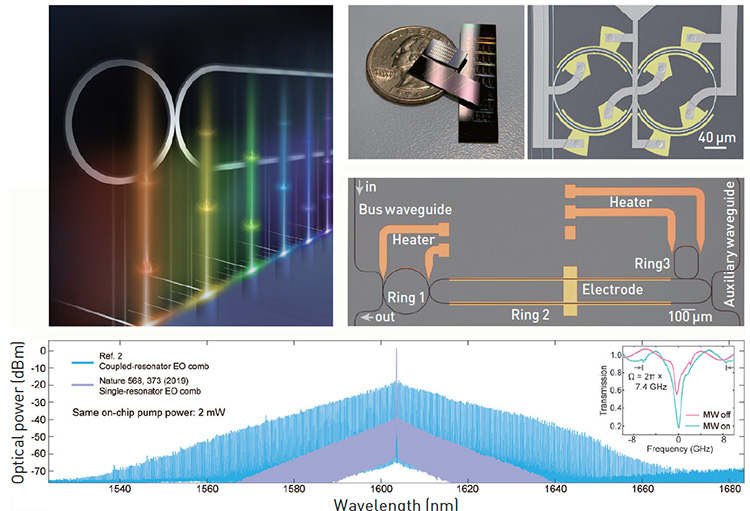 Top left: Artist’s view of photonic coupled resonators. Top right: TFLN coupled- resonator chips, each containing several tens of devices; double-ring frequency shifter. Middle right: Triple-ring cascaded frequency shifter. Bottom: Double-ring electro-optic comb (blue) spectrum with a 100-times-higher efficiency (30%) and a 2.2-times-wider span (132 nm) than previous state-of-the-art electro-optic comb (purple).
Top left: Artist’s view of photonic coupled resonators. Top right: TFLN coupled- resonator chips, each containing several tens of devices; double-ring frequency shifter. Middle right: Triple-ring cascaded frequency shifter. Bottom: Double-ring electro-optic comb (blue) spectrum with a 100-times-higher efficiency (30%) and a 2.2-times-wider span (132 nm) than previous state-of-the-art electro-optic comb (purple).
Optical coupled resonators constitute a versatile platform that offers exciting advantages over single-resonator systems—particularly when realized in highly nonlinear and electro-optic materials. For example, such resonators provide a wealth of discretized and reconfigurable energy levels that can be leveraged to achieve efficient photon–photon (for example, optical, microwave) interactions; to investigate rich nonlinear dynamics; and to realize novel photonic devices. A photonic platform used to implement such coupled-resonator systems must feature low loss, be efficient, support high-bandwidth optical control and be scalable, to provide the strong interactions and long photon lifetimes required for advanced functionalities.
Using emergent thin-film lithium niobate (TFLN) photonics, we recently demonstrated novel coupled-resonator devices with superior performance and previously nonexistent functionalities. We also developed the concept of generalized critical coupling (GCC) to guide device designs.1 Combining these two advances enabled unprecedented ability to control of the flow of light in coupled-resonator systems.
In one set of experiments, we demonstrated electro-optic frequency shifters by combining GCC with optical energy levels coupled to a continuum.1 Using double-ring modulators, we demonstrated frequency shifting of 10–30 GHz with a greater than 99% shift efficiency (shift ratio) and 0.45 dB on-chip insertion loss. Leveraging additional energy levels (modes) in our system enabled cascaded frequency shifting of 120 GHz. Importantly, all frequency shifters required only a continuous and single-tone microwave signal in 10-to-30-GHz range.
We also showed that coupled-resonators realized on TFLN can enable superior frequency combs. By applying double-ring modulators and GCC to electro-optic combs, we demonstrated a 100-fold-higher efficiency (30%) and a 2.2-times-wider span (132 nm) than previous state-of-the-art integrated electro-optic comb sources.2 Furthermore, our system enables generation of femtosecond pulses (336 fs) and allows for frequency combs that combine electro-optic and χ(3) nonlinearities for the first time.
Coupled resonators on TFLN also offer a rich playground for exploring photonic synthetic dimensions. We had previously demonstrated, in 2020, the first 4D frequency crystals on TFLN, using a single resonator.3 Building on this work, we have created frequency-domain synthetic mirrors with reflectivity of greater than 0.9999 using coupled resonators, demonstrating reflections and interference of light with effective optical propagation in the frequency domain.4
Building on these foundations and motivated by both the applications and the rich physics enabled by the platform, we believe that coupled resonators on TFLN will help drive groundbreaking advances in photonic devices and circuits—of interest for microwave photonics, quantum optics, communications, optical computing and topological photonics.
Researchers
Yaowen Hu and Marko Lončar, Harvard University, Cambridge, MA, USA
References
1. Y. Hu et al. Nature 599, 587 (2021).
2. Y. Hu et al. Nat. Photon. 16, 679 (2022).
3. Y. Hu et al. Optica 7, 1189 (2020).
4. Y. Hu et al. Nat. Commun. 13, 6293 (2022).
